Contents
The Agile Method is an adaptive methodology for software development that underscores agility, collaboration with customers, and persistent enhancement. Its repetitive character provides extensive versatility, aptly managing adjustments, which renders it especially proficient during unstable conditions, such as a setback with an earlier software partner or a transition required midway through the project. If you are grappling with any of these challenges, take a moment to go through this article and gain insights into how the team at CrustLab successfully implements the Agile Project Management approach.
What is Project Management?
At its core, project management is the strategic implementation of knowledge, skills, tools, and techniques to orchestrate project activities and meet the defined objectives. The role of a project manager is pivotal in this discipline as they act as the catalyst that transforms an abstract idea into a tangible reality. The project manager’s leadership guides the project team in achieving the desired outcome while adhering to the specified scope, maintaining quality standards, and managing the constraints of time and budget.
Project management is an essential discipline that facilitates collaboration and clear communication among team members. It serves as a road map for the project team, ensuring that each member understands their roles and responsibilities, contributing effectively towards the successful completion of the project. By keeping all team members on the same page, project management helps streamline processes, enhance efficiency, and ensure a unified vision across the board.
The Linear Model: A One-way Track
Linear development, as the name suggests, follows a straight path. This traditional project management approach treats a project as a single, unbroken thread. All the project details are outlined in the planning phase, including features and requirements. This plan then sets the direction for the development team. The team embarks on the linear path, executing each phase in a predefined sequence – from system design to coding, testing, and finally, deployment.
The linear model’s benefit lies in its simplicity and predictability. Each step is well-defined, leaving little room for ambiguity. However, its very strength can also be its weakness. The linear approach lacks flexibility. Once the project begins, it’s challenging to accommodate changes or setbacks without derailing the project’s schedule and budget.
The Waterfall Model: A Step-by-step Descent
The waterfall model, another traditional project management approach, shares many similarities with the linear model. It’s called ‘waterfall’ because it follows a workflow that moves in one direction – downwards, like a waterfall. Each phase of the project cascades into the next, forming a step-by-step sequence.
The waterfall model’s clear structure and step-by-step progression offer an orderly approach to project management. However, like the linear model, it also lacks flexibility. Any changes or setbacks can cause a ripple effect, upsetting the entire project flow. This rigidity can become particularly problematic if a software provider fails to deliver as expected, leaving the project team and clients in a bind, with a half-completed project and limited options for recovery.
While both models have their merits, their inflexibility can pose significant challenges in the dynamic world of software development, where changes are often the norm, not the exception. This led to the rise of Agile project management, offering a more adaptable and resilient approach.
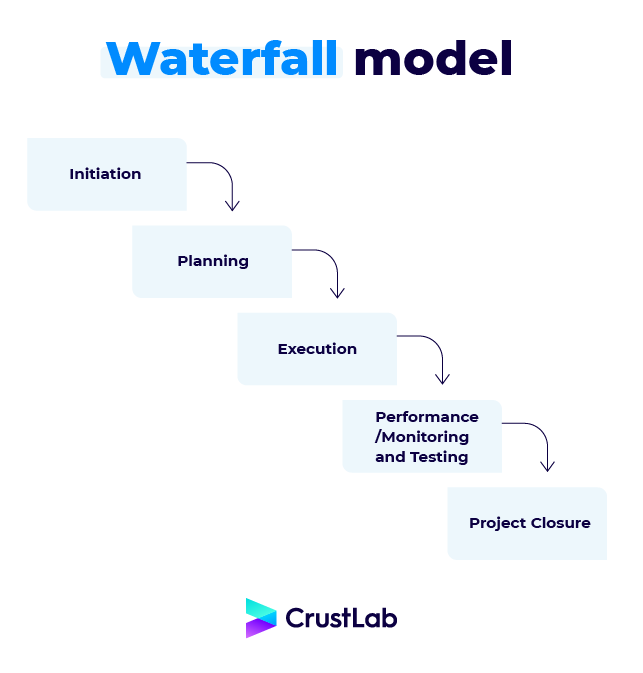
Agile: The Revolutionary Shift from Traditional Project Management
The introduction of the Agile project management methodology marked a paradigm shift in the world of software development. Agile, with its flexible, iterative approach, disrupted the status quo, offering a refreshing alternative to traditional project management models.
Unlike conventional models that call for extensive upfront planning, Agile breaks down the development cycle into manageable, bite-sized units known as “sprints.” These sprints are prioritized based on business or customer value, allowing the project team to review and adjust progress at the end of each cycle. This iterative approach fosters a dynamic environment where adaptability is not only welcomed but also celebrated.
The power of Agile lies in its flexibility and resilience. Agile teams can swiftly adapt to changes, incorporate feedback in real-time, and pivot when necessary without causing a project-wide disruption. This quality makes Agile an effective solution, especially when recovering from a software provider’s failure. With Agile, you can reassess the situation, refocus your efforts, and forge ahead without having to go back to square one.
For industries like iGaming or blockchain, where the only constant is change, Agile provides a reliable and robust framework. When we started with Agile project management, it allowed us to stay at the forefront of innovation, navigate through the dynamic landscape, and deliver quality even amidst uncertainty. With Agile, we are always prepared to turn challenges into opportunities.
Agile Project Management: Mastering the Methodology
Amid an array of management strategies, Agile is pushing the boundaries of traditional methodologies and reshaping the landscape of project management. So, what makes Agile such a formidable force? Dive in as we dissect Agile management, taking you from its historical context to its core Agile principles, and explaining why it’s a pivotal instrument in today’s working software toolkit.
The Origins and Evolution of Agile: A Historical Lens
While Agile seems to be a relatively modern concept, its roots can be traced back to the late 1950s. During this time, iterative and incremental development methods were employed in the creation of software for tech giants like IBM and Motorola. This approach was a marked departure from traditional project management and sowed the seeds for what we now recognize as Agile.
Fast-forward to the dawn of the new millennium, and the software development landscape was ripe for a revolution. The traditional waterfall methodology, with its rigid, linear structure, was proving to be increasingly ill-suited for the fast-paced, ever-evolving world of software development. The need for a more adaptive and flexible methodology was clear, and thus, in 2001, the Agile Manifesto was created.
This seminal moment saw seventeen leading figures in software development come together to pen down a set of values and principles that would guide this new approach. The Agile Manifesto, as it came to be known, laid the philosophical groundwork for Agile, emphasizing people, collaboration, product functionality, and flexibility to change over traditional parameters such as strict plans and heavy documentation. It represented a radical shift in project management philosophy and marked the official birth of Agile as we know it today.
Agile Values: The Heart of Agile Methodology
The Agile Manifesto, upon its creation, distilled the essence of Agile methodology into four core values that continue to guide Agile teams worldwide. These values help shift the focus from rigid processes and documentation to collaboration and adaptability. Here they are:
Individuals and Interactions over Processes and Tools: While processes and tools are important, Agile places a higher value on individuals and their interactions. It acknowledges that the most effective and innovative solutions come from people collaborating effectively.
Working Software over Comprehensive Documentation: Traditional methods often emphasize extensive documentation before a single line of code is written. Agile, however, prioritizes delivering working software. Documentation is still important, but it shouldn’t delay or obstruct the development of a functional product.
Customer Collaboration over Contract Negotiation: Contracts and specifications are necessary, but Agile understands that real-world needs often change and evolve. By promoting regular collaboration with the customer, Agile teams can better understand and respond to these changing requirements.
Responding to Change over Following a Plan: While planning is essential, Agile values the ability to respond to change over rigidly adhering to a plan. It acknowledges that changes are not only inevitable but can also present opportunities for improvement.
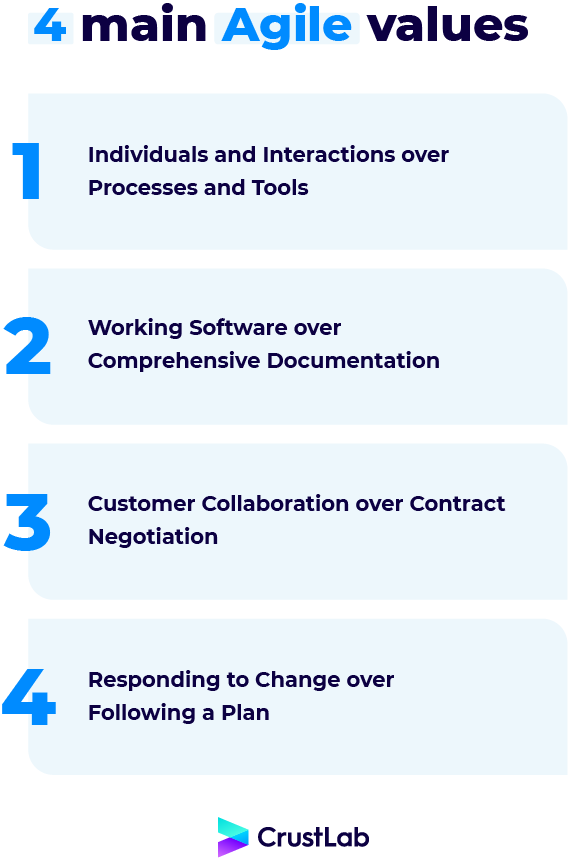
These values are the heart of Agile methodology. They emphasize the human element, practical results, customer involvement, and adaptability – elements that are crucial for the success of any project in the dynamic world of software development.
The Twelve Principles of Agile Project Management
Following the Agile Manifesto, the group further detailed twelve guiding values and principles that provide a roadmap for implementing Agile methodologies. These principles bridge the gap between theory and practice, providing actionable guidance for Agile teams.
Customer satisfaction through early and continuous software delivery: Agile emphasizes the frequent delivery of valuable software. This ensures customers see progress and benefits early, enhancing their satisfaction.
Welcome changing requirements, even late in development: Agile methodologies are designed to adapt to change, not resist it. Changes in requirements are seen as opportunities for improvement, not hindrances.
Deliver working software frequently: Regular delivery of small, functional increments of the software allows for continuous progress and provides the opportunity for regular feedback and adaptation.
Business stakeholders and developers must work together daily: Communication is vital in Agile. Daily collaboration ensures everyone stays on the same page, and any problems can be swiftly addressed.
Build projects around motivated individuals and trust them: Agile places significant trust in the project team. It is believed that motivated individuals, given the necessary support and trust, will deliver the best results.
Face-to-face conversation is the most efficient and effective method of conveying information: Agile promotes direct, clear communication. This often means face-to-face interaction, although in today’s digital age, video conferencing, and similar tools can serve this purpose as well.
Working software is the primary measure of progress: In Agile, fancy reports or extensive documentation are not benchmarks. The actual working software, delivering value to the customer, is the true measure of progress.
Agile processes promote sustainable development: Agile advocates for a consistent, sustainable pace of work. This prevents burnout and maintains high quality over the long term.
Attention to technical excellence and good design enhances agility: Quality is not compromised in Agile. High standards in technical and design aspects ensure the product is robust and adaptable.
Simplicity is essential: Agile promotes a focus on doing only what is necessary and no more. This maximizes efficiency and minimizes waste.
Self-organizing teams produce the best architectures, requirements, and designs: Agile believes in the power of self-organizing teams. Such teams, guided by the project’s needs and their individual expertise, can deliver superior outcomes.
The team should reflect on how to become more effective and adjust behaviors accordingly: Regular retrospection and continuous improvement are cornerstones of Agile. Teams are encouraged to learn from each experience and refine their approach accordingly.
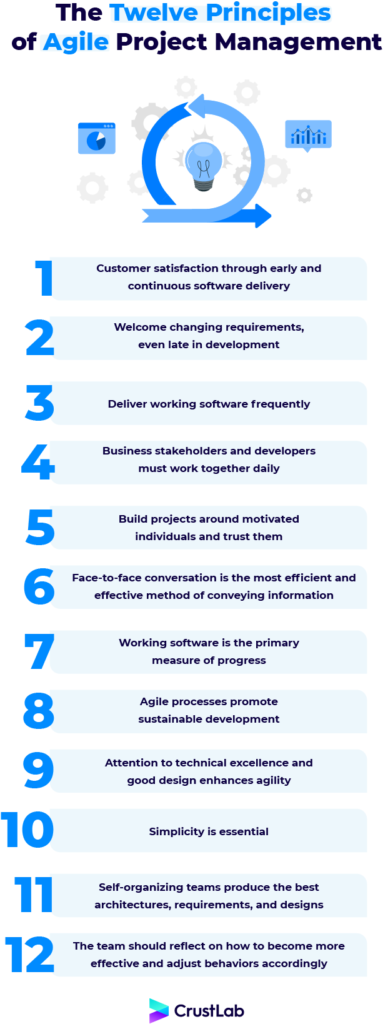
These principles offer a comprehensive view of Agile’s approach to project management, underscoring its commitment to customer satisfaction, team collaboration, adaptability, and continuous improvement.
Key Benefits of Agile Project Management
Adopting the Agile methodology can significantly enhance your software development process, making it more flexible and responsive to changes. Here are some of the key benefits of Agile:
Higher Product Quality: By breaking the project into manageable units, Agile allows for more frequent testing and revision, resulting in a higher quality end product.
Greater Customer Satisfaction: With Agile, customer feedback is integrated throughout the project, resulting in a product that better meets customer needs and expectations.
Improved Project Control: Agile’s iterative approach offers more opportunities for team collaboration and course-correction throughout the project, leading to improved control and project predictability.
Increased Project Visibility: Regular meetings during Agile development—like daily stand-ups and sprint reviews—ensure all stakeholders have a clear vision of the project status and the next steps.
Reduced Risks: Agile mitigates risk by developing and releasing software in increments. This way, if a project fails, not all is lost—much of the work has already delivered value.
Faster ROI: Since Agile development starts delivering working features from the early stages of the project, businesses can start realizing a return on their investment sooner.
Better Adaptability to Change: Agile methodology embraces change. When market conditions or customer needs change, Agile teams can pivot quickly and effectively, turning potential setbacks into opportunities.
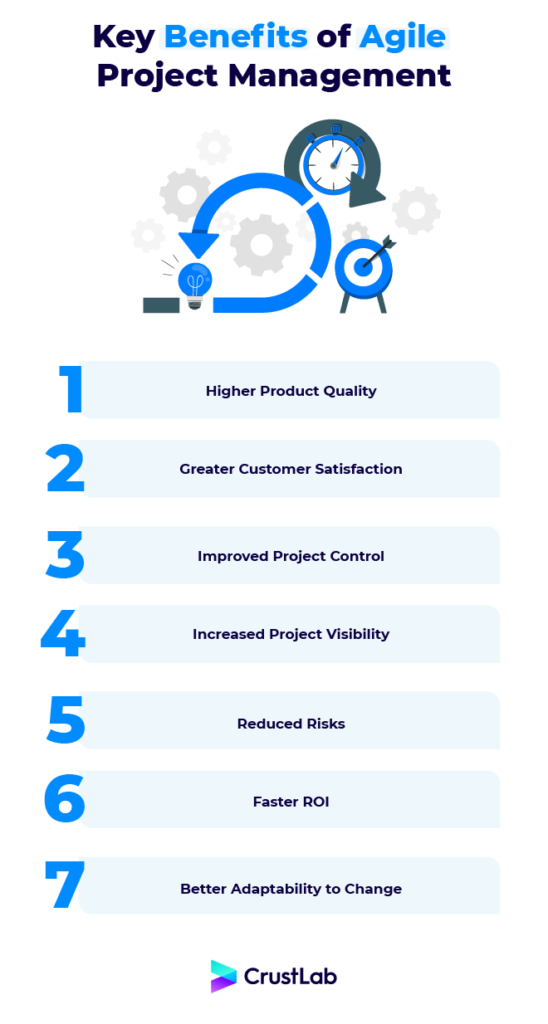
In conclusion, the Agile approach, with its emphasis on adaptability, collaboration, and customer satisfaction, offers considerable benefits. It can enhance productivity, improve product quality, and lead to greater customer satisfaction—all of which contribute to the project’s overall success.
Project Management Phases: Navigating the Roadmap to Success
Every successful project, regardless of its methodology, undergoes a series of phases that serve as a roadmap for the project team. Here’s a look at these phases in the context of project management:
Initiation
This is the first phase where the project’s feasibility is evaluated. It involves identifying the project’s goals, stakeholders, and expected outcomes. It’s also when the Project Manager is assigned, who, along with the team, defines the project’s vision and scope.
Planning
Once the project is green-lit, detailed planning begins. This includes defining tasks, estimating resources and timelines, identifying potential risks, and developing contingency plans. A comprehensive project plan serves as a blueprint for the team, outlining what needs to be done, by whom, and by when.
Execution
This is where the actual work begins based on the project plan. The project team develops the product, adhering to the outlined quality standards and deadlines. Regular meetings ensure that everyone is on the same page and any issues are addressed promptly.
Performance/Monitoring and Testing
Concurrent with execution, this phase involves tracking the project’s progress to ensure it aligns with the plan. Regular reviews, audits, and tests are conducted to monitor performance, quality, and risks. Feedback gathered during this phase helps identify areas for improvement and adjust plans as needed.
Project Closure
Once the project’s objectives have been achieved, the project is closed. This phase includes finalizing deliverables, resolving any outstanding items, releasing project resources, and formally closing contracts. Post-project reviews are also conducted to assess performance and glean lessons for future projects.
Remember, each of these phases is vital in ensuring a project’s success. They provide a structured approach to project management, enabling teams to manage their tasks more effectively, keep stakeholders informed, and deliver results that meet or exceed expectations.
Embracing Agility: A Deep Dive into Agile Methodologies, Frameworks, and Practices
In the world of project management, a ‘one size fits all’ approach doesn’t necessarily yield the best results. Different projects, teams, and contexts require different methodologies and practices. Agile, with its core philosophy of iterative development and customer collaboration, offers a host of frameworks and practices that teams can adapt to their unique circumstances. In this section, we will delve into some of these popular Agile methodologies – Scrum, Kanban, and Hybrid – to help you understand their key features and decide when to use them. Let’s dive in!
Scrum
Scrum is a widely adopted Agile framework that utilizes iterative and incremental practices to optimize predictability and control risk. It empowers cross-functional teams to deliver valuable software in small, manageable chunks called “sprints.”
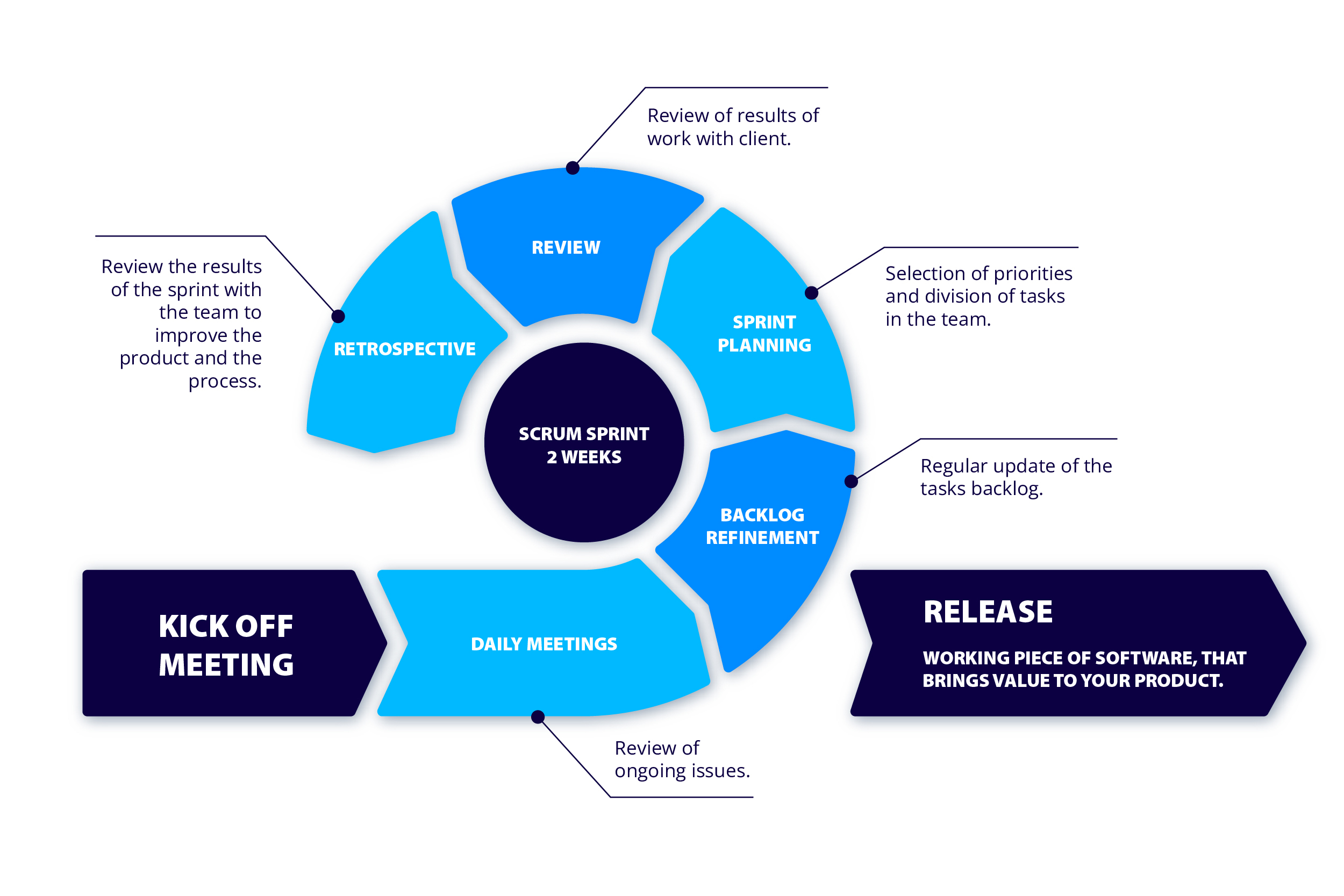
Roles and Accountabilities
A Scrum team usually consists of the Product Owner, the Scrum Master, and the Development Team. The Product Owner sets the vision and prioritizes the work. The Scrum Master facilitates the process, removes impediments, and ensures that the team adheres to Scrum values and practices. The Development Team, usually consisting of 3-9 people, does the actual work of delivering potentially shippable increments of software.
Sprints and Artifacts
Key Scrum artifacts include the Product Backlog, Sprint Backlog, and Burndown Charts. The Product Backlog is a prioritized list of features, while the Sprint Backlog is a set of backlog items selected for the current sprint. Burndown Charts are visual representations of work left to do versus time.
Scrum Meetings
Regular Scrum meetings include Sprint Planning, Daily Scrum, Sprint Review, and Sprint Retrospective. These events create a rhythm of regular inspection and adaptation throughout the project.
When to use Scrum
Scrum is best suited for complex projects where requirements are expected to change frequently. It offers flexibility, allowing teams to adapt to changes quickly and efficiently.
Kanban
Kanban is another Agile methodology that visualizes the workflow, limiting the work-in-progress to improve efficiency and reduce waste. Originally from the Toyota Production System, Kanban is a method for visualizing work, limiting work in progress, and quickly identifying bottlenecks, thus helping teams deliver more consistently.
Kanban Working Principles
The cornerstone of Kanban is the Kanban Board, a tool that visualizes the workflow. Work items move from left to right, each column representing a stage of the process. By seeing the state of all tasks, teams can focus on reducing cycle times and improving throughput.
When to use Kanban
Kanban works well in environments where work arrives in an unpredictable manner, and there is a need for flexibility in terms of planning and execution.
Hybrid: Best of Both Worlds
Hybrid methodologies combine the structured, milestone-centric elements of traditional project management with the flexibility and collaboration of Agile. Hybrid project management takes a pragmatic approach. It embraces the structured oversight of Waterfall and the flexibility and responsiveness of Agile—providing teams with the best of both worlds.
Hybrid Framework Working Principles
A Hybrid model might start with a detailed planning phase, similar to a Waterfall, followed by iterative cycles of execution, similar to Agile. The approach to documentation, change control, and other practices would be a balanced blend of both methodologies.
When to use Hybrid
Hybrid is useful when there are some known requirements and deliverables upfront, but also a need for flexibility and iteration for other parts of the project. It’s also beneficial in organizations transitioning from Waterfall to Agile, providing a less disruptive change.
Each of these frameworks, Scrum, Kanban, and Hybrid, offer unique strengths. The choice depends on the nature of the project, the team’s expertise, and the organization’s culture. What’s important is understanding that these are not rigid rules, but rather guidelines designed to help teams deliver the best possible software.
Get started with the Agile team
At CrustLab, we live and breathe Agile, and for good reasons. The Agile project management methodology isn’t merely a buzzword for us; it’s a strategic approach that helps us tackle many of the common challenges in software development, especially within dynamic industries like iGaming, blockchain, and web 3.0.
Navigating Unpredicted Changes and Uncertainties
In the software development world, change is the only constant. Be it new user demands, emerging technologies, updated regulations, or simply internal improvements – changes are inevitable. Agile’s iterative approach allows us to manage these uncertainties smoothly. We implement feedback, adapt to changes, and innovate – all on the go. For example, if a gaming platform needs sudden feature adjustments due to user feedback or a change in regulations, our Agile approach allows us to incorporate these changes in the next sprint, ensuring minimal disruption.
Reducing Time-to-Market
In competitive sectors like iGaming and blockchain, being the first to deliver a quality product or service can be a game-changer. Traditional project management methods, like the Waterfall model, require the completion of all stages before a product can be released, causing potential delays. Agile, on the other hand, promotes delivering value incrementally. This approach allows us to roll out workable solutions quicker, refining and adding features based on real-time feedback as we proceed. This is particularly beneficial when launching a new sports betting application or a blockchain solution – we can deploy a robust, basic version quickly and progressively enhance it based on actual user feedback and market response.
Optimizing Resource Utilization
Efficient resource management is pivotal in delivering a quality product on time and within budget. Unlike traditional project management where resource allocation is rigid and often leads to inefficiencies, Agile fosters a flexible, cross-functional team setup. Our team members can adapt to the project’s changing needs and take up different tasks, leading to optimized resource utilization and increased productivity. For instance, in a blockchain project, a developer can take up testing tasks for a specific sprint, allowing for a balanced workload distribution and a fluid development process.
Agile is more than a project management methodology for us at CrustLab. It’s a philosophy that empowers us to navigate the ever-evolving software development landscape, ensuring we deliver optimal solutions on time, every time. Contact us today to embark on your Agile journey and shape your success story.


